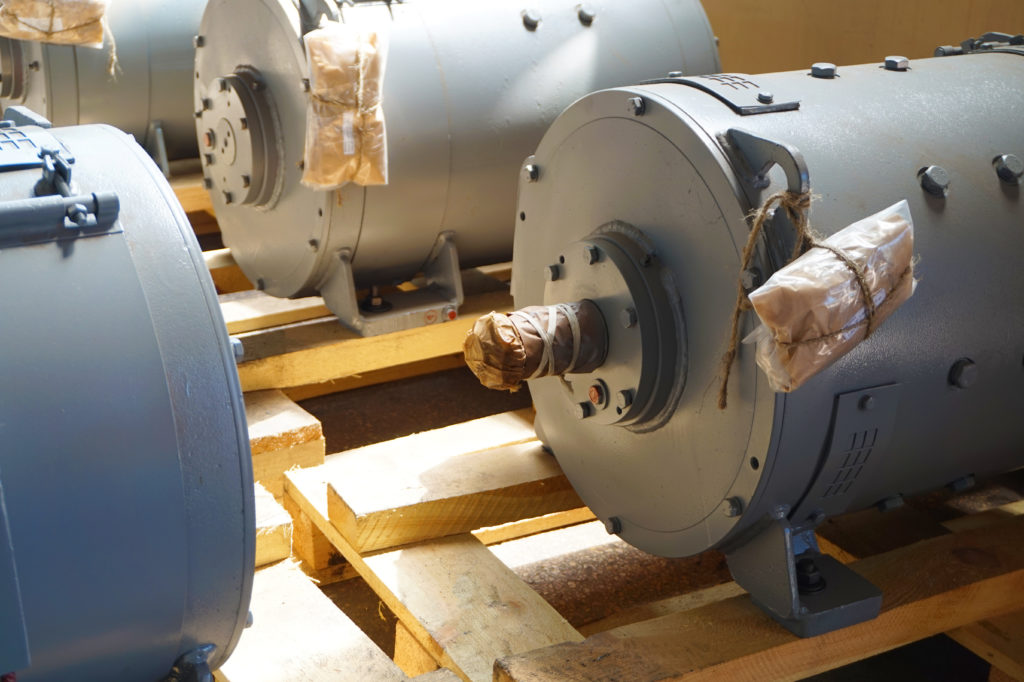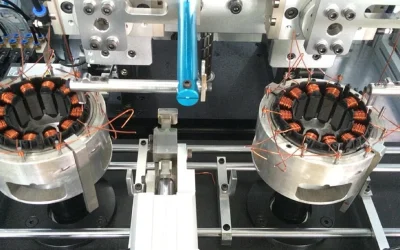
DC motors play a crucial role in numerous machines and devices by converting electrical energy into mechanical energy. They are indispensable in various industries, including transportation, manufacturing, and robotics.
CAM Innovation specializes in designing, manufacturing, and repairing large machinery, including DC motors. While some may view traditional combustion engines as outdated, they have a long-standing history of diverse applications worldwide. This extensive experience has ingrained their operation into many industries, ensuring their continued relevance and reliability.
What is a DC Motor?
A DC (direct current) motor is a prevalent type of electric machine that converts electrical energy into mechanical energy through a magnetic interaction between its windings and field magnets. Fundamentally, a DC motor operates on the principle that an electrical current flowing through a conductor within a magnetic field generates a force, resulting in movement. This motion is harnessed to perform work, such as driving a shaft or moving a load.
Key Components of a DC Motor
To understand how a DC motor operates, we must be familiar with its key components, each playing a crucial role in its functionality:
- Stator: The stationary component within the motor that establishes a magnetic field. This part is typically constructed from either permanent magnets or electromagnets, depending on the motor design. The stator’s role is critical in generating the magnetic field necessary for motor operation.
- Rotor (Armature): This is the part of the motor that rotates and is equipped with coils through which current flows. The rotor is connected to a shaft, and its movement is essential for converting electrical energy into mechanical energy. The interaction between the rotor and stator creates the torque needed for rotation.
- Commutator: A mechanical switch that changes the direction of current flow through the rotor windings. This component is essential to ensure that the rotation of the motor is continuous and smooth. By reversing the current direction at appropriate intervals, the commutator maintains the motor’s consistent motion.
- Brushes: Made of a conductive substance, often carbon, and precoated with materials designed to maintain contact with the commutator. These brushes pass electric current between the power source and commutator. Over time, brushes gradually wear down due to friction and need replacement to ensure efficient motor operation.
- Power Supply: The source of direct current needed to run the motor. This can be a battery or another DC power supply, providing the necessary electrical energy for the motor to function. The power supply’s reliability and capacity directly impact the motor’s performance and efficiency.
How DC Motors Work
DC motors operate by harnessing the interaction between the magnetic field of the stator and the current-carrying conductors in the rotor. Here’s a step-by-step explanation of how they function:
Power Supply Activation: When the power supply is turned on, electrical current flows through the brushes and into the commutator.
Current Flow: The commutator directs the current into the rotor windings, which generates an electromagnetic field.
Magnetic Interaction: This electromagnetic field interacts with the magnetic field of the stator. The interaction between these fields produces a force that causes the rotor to spin.
Commutation: The commutator plays a crucial role by reversing the direction of current in the rotor windings as the armature moves. This reversal is essential to maintain continuous rotation without interruption.
Continuous Rotation: As long as the power supply is active, this cycle repeats, allowing the rotor to spin indefinitely without interruption.
Types of DC Motors
There are many different types of DC motors, each tailored for specific applications. Here are the most common types:
1. Brushed DC Motors
These are the simplest form of DC motors, consisting of a stator, rotor, brushes, and commutators. They are known for their ease of control and cost-effectiveness. Commonly used in toys, small appliances, and automotive systems due to their straightforward design and operation.
2. Brushless DC Motors
In these motors, mechanical commutators and brushes are replaced by an electronic controller that manages the current flow. This design enhances efficiency, reduces maintenance needs, and increases the motor’s lifespan. Brushless DC motors are ideal for applications requiring precise control and reliability, such as in computer hard drives and electric vehicles.
3. Permanent Magnet DC Motors
These motors use permanent magnets to create the magnetic field in the stator, eliminating the need for electromagnets. The design allows for a more compact and simpler motor construction. They are typically used in applications where a lightweight motor is necessary, such as in robotics and portable tools.
4. Series DC Motors
Known for their high starting torque, the field windings in these motors are connected in series with the armature winding. This configuration makes them suitable for applications that require significant torque at startup, like electric cars and cranes.
5. Shunt DC Motors
In shunt DC motors, the field winding is connected in parallel with the armature winding. This setup provides a relatively constant speed under varying load conditions. They are used in applications requiring consistent speed and good regulation, such as machine tools and precision control operations.
6. Compound DC Motors
These motors combine the characteristics of both series and shunt motors, featuring both series and shunt field windings. They offer a good starting torque along with high-speed regulation. Compound DC motors are commonly used in applications like elevators and conveyors, where both torque and speed regulation are important.
Advantages of DC Motors
DC motors are highly valued in engineering for a variety of applications due to several key advantages:
1. Precise Speed Control
DC motors allow for precise control over speed, making them ideal for applications where frequent starting and stopping are required. By adjusting the supply voltage, operators can easily control the speed of the motor, which is particularly useful in applications like sinter hoist motors.
2. High Starting Torque
These motors provide substantial starting torque, which is essential for applications needing immediate power. This characteristic makes DC motors suitable for heavy industrial equipment and machinery.
3. Compact Size
Despite their varied size and weight, DC motors can deliver significant power. This compactness is advantageous in applications where space is limited, as they can fit into confined areas while still providing the necessary power output.
4. Reversibility
DC motors can be easily reversed, allowing for quick changes in direction. This feature is particularly beneficial in applications requiring fast response times, such as electric vehicles and robotics.
5. Simple Construction
The straightforward design of DC motors results in easier maintenance and quicker repairs. This simplicity helps reduce maintenance and production costs compared to more complex motor systems, making them a cost-effective choice for many applications.
DC Motor Maintenance and Repair
DC motors are versatile and widely used across various industries due to their unique characteristics such as high starting torque, precise speed control, and adaptability. Here are some notable applications of DC motors.
- Transportation
DC motors are extensively used in electric and hybrid vehicles, electric trains, and trams. Their high torque and low-speed capabilities make them ideal for propulsion systems in these vehicles. - Industrial Machinery
In manufacturing, DC motors are employed for precise control and high-speed operations in equipment like conveyor systems, robotic arms, and automated assembly lines. Their ability to provide consistent torque and speed control is crucial in these settings. - Mining Equipment
DC motors power heavy-duty mining equipment such as drills, excavators, and conveyor belts. They are favored for their robustness and ability to handle torque-heavy loads in harsh conditions. - Power Tools
Small DC motors are commonly found in cordless drills, saws, and other battery-powered tools. Their compact size and efficiency make them suitable for portable applications. - Aerospace
DC motors are used in aircraft systems to control flaps, landing gear, and other critical components. Their reliability and precision are essential in the aerospace industry. - Home Appliances
Many household appliances, such as vacuum cleaners, washing machines, and fans, utilize DC motors for their simplicity and ease of control. - Robotics
In robotics, DC motors drive wheels, arms, and other moving parts, providing accurate control over speed and torque, which is essential for precise robotic movements.
DC motors continue to be a critical component in various applications due to their adaptability, efficiency, and precise control capabilities. Their role in industries is expected to expand further as technology advances, enabling new innovations and applications.
The future of DC motors remains promising, driven by advancements in technology and a growing demand for efficient and reliable motor solutions.
Here are key trends shaping the future of DC motors:
The Future of DC Motors
1. Brushless DC Motors
Brushless DC (BLDC) motors are gaining popularity due to their high efficiency, low maintenance, and longer lifespan compared to traditional brushed motors. These motors are increasingly used in applications ranging from consumer electronics to electric vehicles (EVs) and industrial automation. The absence of brushes reduces wear and electromagnetic interference, making them ideal for precise and sensitive applications.
2. Smart Technology Integration
The integration of smart technology into DC motors is revolutionizing their functionality. By incorporating sensors and microcontrollers, smart DC motors can provide real-time performance data, enabling predictive maintenance and reducing downtime. This integration enhances efficiency and reduces operational costs, making DC motors more appealing for industrial and consumer applications.
3. Renewable Energy Applications
DC motors are playing a crucial role in renewable energy systems, such as solar and wind power. They are used in solar tracking systems to optimize panel positioning and in wind turbines for pitch and yaw control, offering precise motion control and high efficiency. These applications highlight the adaptability of DC motors in supporting sustainable energy solutions.
4. Electric Vehicles
With the rise of electric vehicles, DC motors, especially brushless variants, are becoming integral to EV powertrains. Their high torque and efficiency make them suitable for various automotive applications, including propulsion and auxiliary systems like power steering and window lifts. As battery technology advances, DC motors will continue to be a key component in enhancing EV performance and efficiency.
5. Advanced Control Systems
Advanced control systems such as Field-Oriented Control (FOC) and Direct Torque Control (DTC) are enhancing the performance of DC motors. These systems allow precise speed and torque regulation, making DC motors more versatile and efficient in various applications. The development of such control technologies is crucial for optimizing motor performance in complex and demanding environments.
Conclusion
Overall, the future of DC motors is characterized by increased efficiency, integration with smart technologies, and expanded applications in renewable energy and electric vehicles. These trends are set to drive the growth and innovation of DC motors in the coming years.
DC motors have been a cornerstone of industrial applications for over a century, playing a crucial role in everything from small toys to massive mining machinery. Their versatility and reliability make them indispensable in various sectors. For professionals in industries utilizing these machines, understanding their operation and the significance of regular maintenance is essential. As technology continues to advance, DC motors will remain vital, with innovations enhancing their capabilities. At CAM Innovation, we are thrilled to contribute to this ongoing evolution, equipped with the tools and expertise to keep these motors running efficiently.
FAQs
- Can DC motors be used with AC power?
Yes, DC motors can operate with AC power when connected through a rectifier, which converts AC to DC. This setup is common in devices like fans, where AC power is converted to DC to control speed. - Are DC motors more efficient than AC motors?
Efficiency depends on several factors. Generally, AC motors are more efficient today, but DC motors offer better control and higher starting torque, making them preferable for certain applications. - How often should DC motors be serviced?
The servicing frequency for DC motors varies. Large industrial motors may need servicing every few months, while smaller motors in less demanding environments can go years without maintenance. - Can a faulty DC motor be repaired, or does it need to be replaced?
Many DC motors, especially larger and more costly ones, can be repaired on-site. Common repairs include replacing brushes, re-winding armatures, or turning commutator bodies.



